When we host a party, my wife often tells me she wants a cocktail(s) that will pair with food “X” for which she can coordinate a name, even the colors she wants. This time she wanted a cocktail with tequila and pineapple. While there are a few delicious, classic pineapple/tequila cocktails, most of these drinks are sweet and poorly balanced. Now I’ll digress!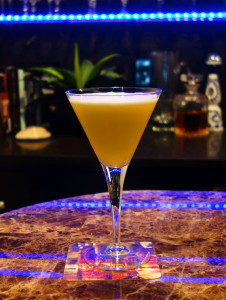
You can download this spread sheet, Pineapple Simple Sour, follow the directions and skip the explanation below. Then just jump down to the recipe here.
The problem you encounter when you substitute one juice for another in a cocktail, especially if you swap a citrus for a non-citrus juice, is loss of balance. The drink easily becomes too sweet, (the most frequent result), too sour (acidic), too bitter, too strong or too weak. The example for this cocktail is pineapple juice, but this discussion is equally true of orange, strawberry, apple or practically any juice. When you substitute all or part of lime or lemon juice with pineapple juice, you are decreasing the primarily acidic and not very sweet lime/lemon juice and adding the sweet and not as acidic pineapple juice. Lime juice is 6% acid and 1.5% sugar, while pineapple juice is 0.8% acid and 10% sugar. Let’s say that you have a cocktail that is:
- 2 parts Spirit (45% ABV)
- 2 parts Lime juice
The above drink will have an ABV of 22.5% and will be 3% acid and 0.75% sugar … and will not be very good. If you were to add 2 parts pineapple juice, your drink will have an ABV of 15%, and will be 2% acid and about 4% sugar. While adding pineapple juice to the above drink would probably be an improvement, it will still be a completely different cocktail. Now, think about the above with 1 part simple syrup. Figuring out how to maintain the cocktails sweet/sour balance quickly becomes mind numbing.
Dave Arnold extensively covers all of this in his book, Liquid Intelligence. A book I highly recommend. His suggestion for solving the above substitutions is to add acid to the juice to make it equal in acidity to lime juice. Then you can sub away. I heard Dave speak at this year’s San Antonio Cocktail Conference. In addition to discussing the above, Dave covered creating fruit juice syrup with the same sugar content by weight as 1:1 simple syrup. It is not uncommon for a cocktail to be 20% simple syrup. That means a 20% dilution. If you use a fruit simple syrup, you will still be diluting the ABV and acidity, but you’ll at least be enforcing the fruit flavor. This is all a whole lot easier than it sounds.
Acidifying Fruit Juice
Lime juice has both citric and malic acids. So, to acidify a juice, you need only know the percent acid in that juice and subtract that from 6% (the acid content of lime juice). Since pineapple juice is 0.8% acid, 6%-0.8% = 5.2%. To acidify a liter of pineapple juice, you will add 32 gm of citric acid and 20 gm of malic acid. Pineapple juice has a highly variable quantity of pulp, even if you filter it. This means that 1 liter of pineapple juice will actually weigh more than 1 Kg. However, it usually makes little difference, so you can just measure out 1 liter of juice and add 32 gm of citric acid and 20 gm of malic acid. The spread sheet above, actually asks you to weigh 1 cup of juice because it also calculates your pineapple simple syrup.
Making Pineapple Simple Syrup
Simple syrup is made by dissolving 1 part sugar in 1 part water. This should be by weight, though it’s frequently made by volume. The issue with making a syrup from fruit juice is that the juice already contains sugar. Adding the full quantity of sugar by weight or by volume will result in a syrup that is too sweet, thus easily unbalancing your cocktail. To avoid this, you need to know the weight of sugar in the juice and the weight of the liquid – which will equal the weight of the sugar to make 1:1. If you’re using bottled juice, 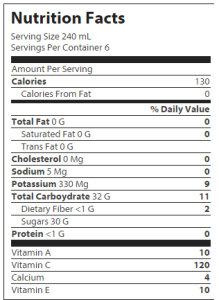 just look at the label to see the weight of sugar in a “serving” of the juice. The weight of sugar per volume will vary by brand. The nutritional chart shown here indicates that 240 ml of juice contains 30 grams of sugar. If you’re using fresh juice, consult the Google! So to use this juice:
just look at the label to see the weight of sugar in a “serving” of the juice. The weight of sugar per volume will vary by brand. The nutritional chart shown here indicates that 240 ml of juice contains 30 grams of sugar. If you’re using fresh juice, consult the Google! So to use this juice:
- Weigh 240 ml of juice in grams
- Subtract 30 grams (the weight of sugar in that juice) to calculate the weight of liquid.
- The weight of the liquid will equal the weight of sugar needed. But you already have 30 grams of sugar. So subtract 30 from the calculated weight of liquid to equal the weight of additional sugar needed.
So by example:
- Lets say the 240 ml of juice weighed 250 grams
- The liquid weight will equal: 250-30 = 220 grams
- You need 220 grams of sugar. But, you already have 30 grams.
- Therefore, the weight of additional sugar needed will equal 220-30 = 190 grams.
Or you can use the spread sheet: Pineapple Simple Sour
The Ghost of Birthdays Past
The only extra tool you will need for this is a digital kitchen or postal scale that will measure in grams. You can purchase one from Amazon here. You will also need to purchase citric and malic acid, also available from Amazon.
The name of this cocktail is derived from Ghost Tequila and the fact that I made the drink for my birthday! The flavors are pineapple and the tequila with the Ghost Tequila bringing just a touch of heat. You can alter the amount of Ghost Tequila to adjust the spiciness to fit your taste.
Ingredients:
- 1/2 oz. Ghost Tequila
- 1 1/2 oz. Silver tequila such as Milagro
- 2 1/2 oz. Acid adjusted pineapple juice
- 1 1/2 oz Pineapple Simple Syrup
- 1/4 oz. Cointreau or triple sec
- To make the Acidified Pineapple juice and the pineapple simple syrup, refer to the spread sheet: Pineapple Simple Sour
- Chill a large, stemmed glass with ice and water
- Add all ingredients to a cocktail shaker with ice
- Shake to chill
- Double strain into chilled glass
Cheers!
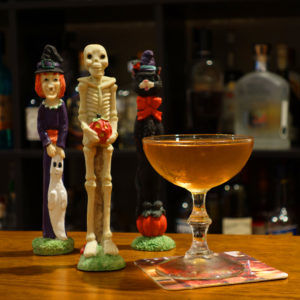

 style gin is distilled with juniper as the only botanical, barrel aged in new American Oak, then sweetened with raw honey. The Mezcal we selected is Mezcalero No. 12, which was made from wild agave. Together they create a very pleasant cocktail. The nose is juniper with a touch of smoke and floral notes. The taste is juniper, honey, and a bit of wood. The finish is slightly sweet and savory.
style gin is distilled with juniper as the only botanical, barrel aged in new American Oak, then sweetened with raw honey. The Mezcal we selected is Mezcalero No. 12, which was made from wild agave. Together they create a very pleasant cocktail. The nose is juniper with a touch of smoke and floral notes. The taste is juniper, honey, and a bit of wood. The finish is slightly sweet and savory.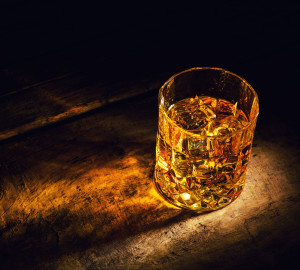
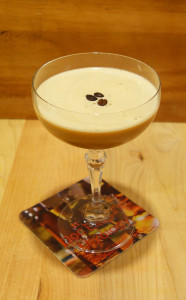 This is a rich, bittersweet version of an Irish coffee. I’ve used coffee syrup, which is easy to make and works much better than hot brewed coffee in cold cocktails. The flavors are coffee first with a background of bittersweet and a creamy texture.
This is a rich, bittersweet version of an Irish coffee. I’ve used coffee syrup, which is easy to make and works much better than hot brewed coffee in cold cocktails. The flavors are coffee first with a background of bittersweet and a creamy texture.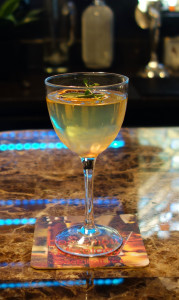
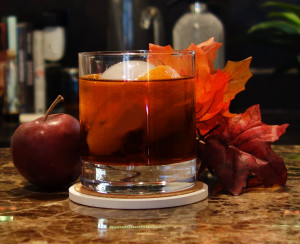
 I enjoy paring cocktails with food, especially if creating a new drink. We were serving salmon and asparagus the other day. Since asparagus does not pare with any wine, this seemed the perfect opportunity for a cocktail! Cue the
I enjoy paring cocktails with food, especially if creating a new drink. We were serving salmon and asparagus the other day. Since asparagus does not pare with any wine, this seemed the perfect opportunity for a cocktail! Cue the 
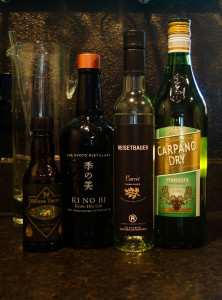

 just look at the label to see the weight of sugar in a “serving” of the juice. The weight of sugar per volume will vary by brand. The nutritional chart shown here indicates that 240 ml of juice contains 30 grams of sugar. If you’re using fresh juice, consult the Google! So to use this juice:
just look at the label to see the weight of sugar in a “serving” of the juice. The weight of sugar per volume will vary by brand. The nutritional chart shown here indicates that 240 ml of juice contains 30 grams of sugar. If you’re using fresh juice, consult the Google! So to use this juice: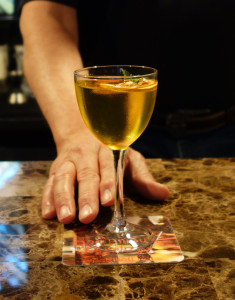 I fell in love with Suze at first taste. The full-bodied citrus and herbs and the long spicy, bitter finish had me! I frequently use it as a modifier to add richness and a little herbal bitterness to various cocktails. Almost a secret ingredient.
I fell in love with Suze at first taste. The full-bodied citrus and herbs and the long spicy, bitter finish had me! I frequently use it as a modifier to add richness and a little herbal bitterness to various cocktails. Almost a secret ingredient.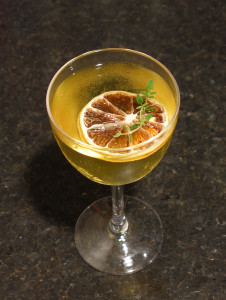
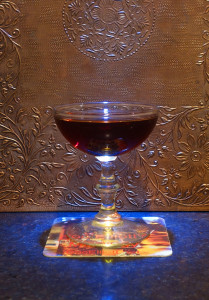 Bourbon goes with many things, but apples, cinnamon and chocolate top my pairings list. For the bourbon in this cocktail, I used Ranger Creek’s .36 Texas Straight Bourbon Whiskey which gently nips but doesn’t bite. It brings the flavors of vanilla, cinnamon and a touch of oak. If you choose a different bourbon, I suggest something that isn’t overly smooth. I used Bigallet China-China Amer as a modifier. Alone, this liqueur tastes of bitter orange, citrus, and cherries with an earthy, root touch similar to cola, (think bourbon and coke). I added the bitters for complexity and to introduce chocolate, additional cinnamon and a bit of dried fruit from the fig bitters.
Bourbon goes with many things, but apples, cinnamon and chocolate top my pairings list. For the bourbon in this cocktail, I used Ranger Creek’s .36 Texas Straight Bourbon Whiskey which gently nips but doesn’t bite. It brings the flavors of vanilla, cinnamon and a touch of oak. If you choose a different bourbon, I suggest something that isn’t overly smooth. I used Bigallet China-China Amer as a modifier. Alone, this liqueur tastes of bitter orange, citrus, and cherries with an earthy, root touch similar to cola, (think bourbon and coke). I added the bitters for complexity and to introduce chocolate, additional cinnamon and a bit of dried fruit from the fig bitters.
 When I think of a dessert drink, my mind usually lands first on coffee. When I think of dessert, chocolate usually wins, (like everyone else, right?). So, my dessert cocktails frequently incorporate coffee and chocolate. My list of after dinner drinks includes several sweet cocktails. I prefer my dessert cocktail to be not overly sweet. That’s probably because, while I might start out thinking the cocktail is my dessert, I usually end up eating something sweet as well. So, I like dessert cocktails that do double duty as a stand alone dessert or as an accompaniment to a dessert, (read chocolate cake).
When I think of a dessert drink, my mind usually lands first on coffee. When I think of dessert, chocolate usually wins, (like everyone else, right?). So, my dessert cocktails frequently incorporate coffee and chocolate. My list of after dinner drinks includes several sweet cocktails. I prefer my dessert cocktail to be not overly sweet. That’s probably because, while I might start out thinking the cocktail is my dessert, I usually end up eating something sweet as well. So, I like dessert cocktails that do double duty as a stand alone dessert or as an accompaniment to a dessert, (read chocolate cake).